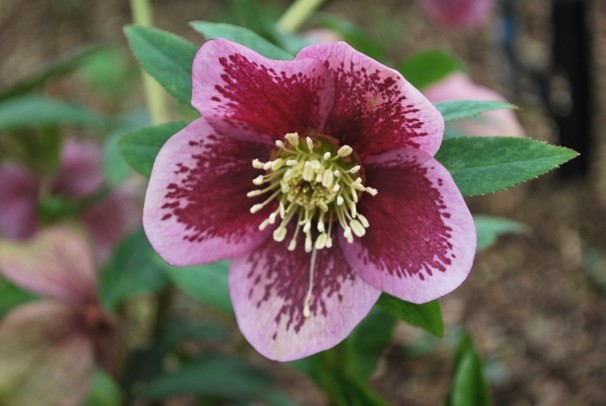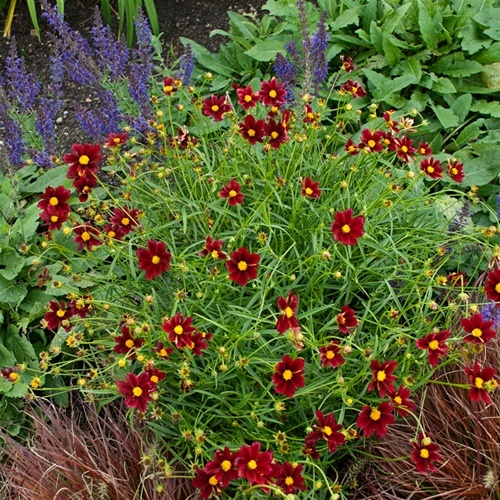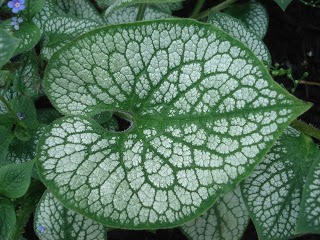Coreopsis is a hard-working, lunch-pail-toting plant for the flower garden. Most of them are yellow and fairly short, so they go in the front of the bed, and they will bloom from mid-summer through fall if they are property deadheaded. A good plant, if not overly exciting.
Coreopsis “Mercury Rising” is bringing some star power to the family of plants.
“It’s an exciting red coreopsis that is hardy to Zone 5,” which covers southern and parts of central Maine, said Jim Masse, nursery manager for Estabrooks in Yarmouth. “Most of the original coreopsis that were red weren’t hardy. And it blooms all summer.”
Elaine Bouchard of Skillins Greenhouses in Falmouth described “Mercury Rising” as a “bright orange-red with gold centers that will really stand out.”
That was just one of several plants that nursery professionals mentioned during my annual nursery survey of new plants.
Cindy Carroll, perennials manager at O’Donal’s Nursery in Gorham, is excited about some hellebores, also known as Lenten rose. These are early plants that have already bloomed in much of southern Maine.
” ‘Ballerina Ruffles’ has a nice leathery leaf that puts on a good show in the shade garden, producing good shades of pink from light pink to bright lipstick,” Carroll said. “And the flowers retain their color for up to 12 weeks after the bloom is spent.”
Jeff O’Donal of O’Donal’s Nursery is more into woody plants than herbaceous perennials. He is excited about “Ruby Falls” Cercis, which is a weeping redbud with purple foliage.
“It’s a hybrid of ‘Lavender Twist’ cloned with ‘Forest Pansy,’ ” O’Donal said. “‘Lavender Twist’ has a strong, cascading form, while ‘Forest Pansy’ has the rich purple foliage. Lavender Twist comes from the Adirondacks, and shows better hardiness than weeping forms.”
He says it’s a beautiful tree, and he hopes it has the hardiness that its parentage would suggest.
Bouchard also likes “Sea Heart” Brunnera, also known as perennial forget-me-nots. “It has a nice mottled foliage that is different from ‘Jack Frost,’ ” which was the perennial plant of the year in 2012. “It is an interesting plant, not only for its flower, but for its foliage too.”
Masse believes that Gaura “So White” is going to be a wonderful addition to Maine gardens. It has pure white flowers, and the stems have no pink color to them, as other white gauras do.
“It blooms all summer long, and even though it can be a tender perennial in Zone 5, it adds a lot of dynamism and movement, whether it is in containers or in the ground,” he said.
Bouchard is taken with Filipendula “Red Umbrellas.”
“It has these really rich red veins in the foliage,” she said, “in addition to pink flowers in the summer.”
Carroll found out about a new meadow rue, Thalictrum “Elin,” at a lecture by Richard Hawke at New England Grows this winter, and she was so taken with it that she ordered some for the nursery.
“It is a new thalictrum that does not need staking, and I am anxious to see how sturdy it is,” she said.
The plant’s shoots emerge from the ground as purple, then produce fine-cut green foliage. When the flowers emerge, they are a mixture of mauve and cream, and because it is a hybrid that does not produce seeds, the blossoms last a long time. It is expected to be a great back-of-the-border plant.
Masse likes the “Halo Cerise” hollyhock that is a single saucer-shaped blossom, a hardier version of the hollyhock that is a bright purple-red.
“It brings some old-time romance to your garden with a modern hybrid that is more perennial than most hollyhocks,” he said.
Back to the woodies, O’Donal is excited to have more “Florence Parks” rhododendrons available for sale for this.
This rhododendron has large purple flowers on a hardy, broad plant, and was developed by Joe Parks, who lived in New Hampshire and donated his collection to the University of Southern Maine, where it is now growing. O’Donal hopes to have other Parks rhododendrons available in liners this year as well.
O’Donal is also excited about a new London planetree called “Exclamation,” which is supposed to be resistant to the sun scald that can result in splitting in most of the planetrees that were planted 40 and 50 years ago.
This tree will grow to 75 feet, so you will want to have room for it, but has huge leaves and a beautiful peeling bark that is a mixture of green and beige.
Tom Atwell has been writing the Maine Gardener column since 2004. He is a freelance writer gardening in Cape Elizabeth and can be contacted at 767-2297 or at:
tomatwell@me.com
Send questions/comments to the editors.





Success. Please wait for the page to reload. If the page does not reload within 5 seconds, please refresh the page.
Enter your email and password to access comments.
Hi, to comment on stories you must . This profile is in addition to your subscription and website login.
Already have a commenting profile? .
Invalid username/password.
Please check your email to confirm and complete your registration.
Only subscribers are eligible to post comments. Please subscribe or login first for digital access. Here’s why.
Use the form below to reset your password. When you've submitted your account email, we will send an email with a reset code.